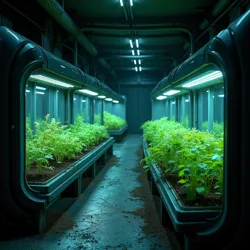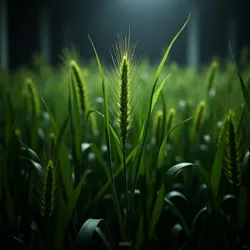Dark Agriculture
 A modern dark agriculture facility showing bioluminescent fungi and piezo-powered growth chambers
A modern dark agriculture facility showing bioluminescent fungi and piezo-powered growth chambersDark agriculture represents a revolutionary approach to food production that enables plant and fungal cultivation in completely lightless environments. This innovative agricultural paradigm has emerged as a critical technology for underground habitation, deep space colonization, and resource-constrained environments. By fundamentally reimagining the biological requirements for plant growth, dark agriculture has created new possibilities for food security and agricultural sustainability.
Core Technologies
The foundation of dark agriculture rests on several breakthrough technologies that allow organisms to thrive without photosynthesis. Metabolic pathway engineering has enabled the development of plants that can derive energy from chemical processes rather than sunlight. These modified organisms utilize enhanced root systems with dramatically increased surface area and absorption efficiency, often called "greedy roots," to extract maximum nutrients from their growth medium.
A crucial advancement in dark agriculture has been the development of bespoke microbiomes - carefully crafted communities of bacteria and fungi that form symbiotic relationships with dark-adapted plants. These microorganisms assist in nutrient acquisition, energy generation, and even structural support. The microbiomes often include specialized nitrogen-fixing bacteria that can convert atmospheric nitrogen into forms readily usable by plants, reducing or eliminating the need for traditional fertilizers.
Energy Generation and Utilization
Dark agriculture systems employ multiple novel energy-generation mechanisms to power plant growth. Piezoelectric systems harvest energy from ambient vibrations, converting mechanical stress into electrical energy that can be utilized by modified plant cells. This technology is particularly effective in facilities located near geological activity or human infrastructure.
Triboluminescence - the emission of light from mechanical stress - has been engineered into certain plant varieties, creating self-illuminating crops. These plants can generate brief bursts of light during normal growth movements, which are then captured by specialized cellular structures for energy production. This process, known as auto-illumination cycling, represents a significant breakthrough in energy-efficient cultivation.
 A specimen of self-illuminating wheat developed through dark agriculture techniques
A specimen of self-illuminating wheat developed through dark agriculture techniquesParasitic and Saprophytic Adaptations
Dark agriculture has drawn inspiration from naturally occurring parasitic and saprophytic organisms. Engineered parasitism allows some crop varieties to extract nutrients directly from host organisms or synthetic nutrient delivery systems. These plants develop specialized structures similar to those found in natural parasitic plants like dodder or mistletoe, but with precisely controlled growth patterns and resource extraction rates.
Saprophytic adaptations enable crops to derive nutrients from dead organic matter, similar to many fungi. This capability has led to the development of cyclic cultivation systems where plant waste becomes a primary nutrient source for subsequent generations. These systems achieve remarkable efficiency in nutrient recycling and waste reduction.
Applications and Implementation
Dark agriculture facilities typically consist of carefully controlled growth chambers that optimize temperature, humidity, and nutrient delivery. These environments often incorporate piezo-reactive materials in their construction to maximize energy harvesting potential. Advanced monitoring systems track nutrient levels, microbial population dynamics, and plant health in real-time.
The technology has found particular success in subterranean farming complexes and orbital agriculture stations, where traditional sunlight-based farming is impossible. These facilities often combine multiple dark agriculture approaches, creating robust and redundant systems that ensure reliable food production even in extreme conditions.
Challenges and Future Developments
Despite its advantages, dark agriculture faces several ongoing challenges. The energy requirements for maintaining optimal growing conditions can be substantial, though this is partially offset by the elimination of traditional lighting systems. Additionally, the complex genetic modifications required for dark-adapted crops raise important questions about biosafety protocols and genetic stability over multiple generations.
Current research in dark agriculture focuses on developing more efficient energy capture mechanisms and improving the stability of engineered traits. Scientists are also exploring the potential of hybrid systems that combine dark agriculture techniques with traditional growing methods, creating more versatile and resilient food production systems.
Economic and Social Impact
The emergence of dark agriculture has led to significant changes in agricultural economics and food security planning. The ability to grow crops in previously unsuitable locations has sparked the development of new agricultural economic models and changed approaches to urban planning and resource distribution.
These technologies have also influenced discussions about food sovereignty and local production capacity, particularly in regions with limited arable land or challenging environmental conditions. The potential for year-round cultivation regardless of external conditions has made dark agriculture an increasingly important consideration in global food security strategies.
Cultural Significance
Dark agriculture has begun to influence various aspects of culture and society, from architecture to cuisine. The emergence of dark gastronomy - a culinary movement focused on foods produced through dark agriculture - has led to new flavor profiles and cooking techniques. Additionally, the aesthetic of dark agriculture facilities has inspired new directions in industrial design and urban planning.
The development of dark agriculture represents a significant shift in humanity's relationship with food production and biological systems. As the technology continues to evolve, it promises to play an increasingly important role in addressing global food security challenges while opening new frontiers in agricultural science and biological engineering.